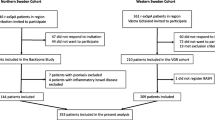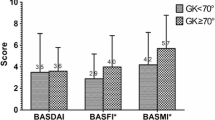Abstract
The objective of this study is to investigate the association between clinical and laboratory prognostic factors, radiographic severity, and functional limitations in Turkish patients with ankylosing spondylitis (AS). One hundred and two patients with AS were included in this study (66 male patients, 65%). All the necessary information regarding predictor variables, including clinical features, social status, and treatment regimens, were recorded diligently. Their spinal mobility was measured, and then, their disease activities were evaluated by using the Bath Ankylosing Spondylitis Disease Activity Index. Radiological damage (Bath Ankylosing Spondylitis Radiology Index, BASRI) and functional disability (Bath Ankylosing Spondylitis Functional Index, BASFI) were used to evaluate the outcome measures of AS. The male to female ratio was 1.8. Average age at symptom onset was 23.9 ± 28.24 years (6–54 years), and average disease duration was 16.15 ± 10.62 years. Occiput-to-wall distance, hand-to-floor distance, and the modified Schober's test results were worse in males. Hip involvement was more common in male patients, and all radiological measurements were worse in male patients than in the female ones. Disease duration, male sex, and renal stone occurrence were associated with higher radiological score. Erythrocyte sedimentation rate and the disease activity score were associated with high BASFI scores. Higher CRP levels and hip involvement were both associated with high BASRI and BASFI scores. Radiological hip involvement was determined to be an inauspicious predictor for AS (p < 0.0001). We determined a strong association of hip involvement, increased CRP levels, and renal stone history with severe radiographic damage. Hip involvement, disease duration, ESR, CRP levels, and lower socioeconomic status were all associated with a higher BASFI score.
Similar content being viewed by others
References
Van der Heijde D (2008) Ankylosing spondylitis. In: Klippel JH, Stone JH, Crofford LJ, White PH (eds) Primer on the rheumatic diseases, 13th edn. Springer, Berlin
Amor B, Silva-Santos R, Nahal R, Listrat V, Doudados M (1994) Predictive factors of the long term outcome of spondylarthropathies. J Rheumatol 21:1883–1887
Gran JT, Skomsvoll JF (1997) The outcome of ankylosing spondylitis: a study of 100 patients. Br J Rheumatol 36:766–771
Mau W, Zeidler H, Mau R et al (1988) Clinical features and prognosis of patients with possible ankylosing spondylitis. Results of a 10-year followup. J Rheumatol 15:1109–1114
Doran MF, Brophy S, MacKay K, Taylor G, Calin A (2003) Predictors of longterm outcome in ankylosing spondylitis. J Rheumatol 30:316–320
Brophy S, Calin A (2001) Ankylosing spondylitis: interaction between genes, joints, age at onset, and disease expression. J Rheumatol 28:2283–2288
Ward MM (2002) Predictors of the progression of functional disability in patients with ankylosing spondylitis. J Rheumatol 29:1420–1425
Ward MM, Hendrey MR, Malley JD et al (2009) Clinical and immunogenetic prognostic factors for radiographic severity in ankylosing spondylitis. Arthritis Rheum 61:859–866
Roussou E, Kennedy LG, Garrett S, Calin A (1997) Socioeconomic status in ankylosing spondylitis: relationship between occupation and disease activity. J Rheumatol 24:908–911
Marks SH, Barnett M, Calin A (1982) A case-control study of juvenile and adult-onset ankylosing spondylitis. J Rheumatol 9:739–741
Korkmaz C, Özcan A, Akçar N (2005) Increased frequency of ultrasonographic findings suggestive of renal stones in patients with ankylosing spondylitis. Clin Exp Rheumatol 23:389–392
van der Linden S, Valkenburg HA, Cats A (1984) Evaluation of diagnostic criteria for ankylosing spondylitis. A proposal for modification of the New York criteria. Arthritis Rheum 27:361–368
Goldthorpe JH, Pope K (1977) The social grading of occupations- a new approach to the scale. Clarendon Press, Oxford
Calin A, Mackay K, Santos H, Brophy S (1999) A new dimension to outcome: application of the Bath Ankylosing Spondylitis Radiology Index. J Rheumatol 26:988–992
Calabro J, Amante CM (1969) Prognosis in ankylosing spondylitis. Arthritis Rheum 8:471
Carette S, Graham D, Little H, Rubenstein J, Rosen P (1983) The natural disease course of ankylosing spondylitis. Arthritis Rheum 26:186–190
Lee W, Reveille JD, Davis JC Jr, Learch TJ, Ward MM, Weisman MH (2007) Are there gender differences in severity of ankylosing spondylitis? Results from the PSOAS cohort. Ann Rheum Dis 66:633–638
Ward MM, Weisman MH, Davis JC Jr, Reveille JD (2005) Risk factors for functional limitations in patients with long-standing ankylosing spondylitis. Arthritis Rheum 53:710–717
Wordsworth BP, Mowat AG (1986) A review of 100 patients with ankylosing spondylitis with particular reference to socio-economic effects. Br J Rheumatol 25:175–180
Averns HL, Oxtoby J, Taylor HG, Jones PW, Dziedzic K, Dawes PT (1996) Smoking and outcome in ankylosing spondylitis. Scand J Rheumatol 25:138–142
Incel NA, Gokoglu F, Nacir B, İncel N (2006) Bone and stone in ankylosing spondylitis: osteoporosis and urolithiasis. Clin Rheumatol 25:667–670
Khan MA, Kushner I, Braun WE, Zachary AA, Steinberg AG (1978) HLA-B27 homozygosity in ankylosing spondylitis: relationship to risk and severity. Tissue Antigens 11:434–438
Suarez-Almazor ME, Russell AS (1987) B27 homozygosity and ankylosing spondylitis. J Rheumatol 14:302–304
Ruof J, Stucki G (1999) Comparison of the Dougados Functional Index and the Bath Ankylosing Spondylitis Functional Index. A literature review. J Rheumatol 26:955–960
Disclosures
None.
Author information
Authors and Affiliations
Corresponding author
Rights and permissions
About this article
Cite this article
Cansu, D.Ü., Çalışır, C., Savaş Yavaş, U. et al. Predictors of radiographic severity and functional disability in Turkish patients with ankylosing spondylitis. Clin Rheumatol 30, 557–562 (2011). https://doi.org/10.1007/s10067-010-1665-2
Received:
Revised:
Accepted:
Published:
Issue Date:
DOI: https://doi.org/10.1007/s10067-010-1665-2




